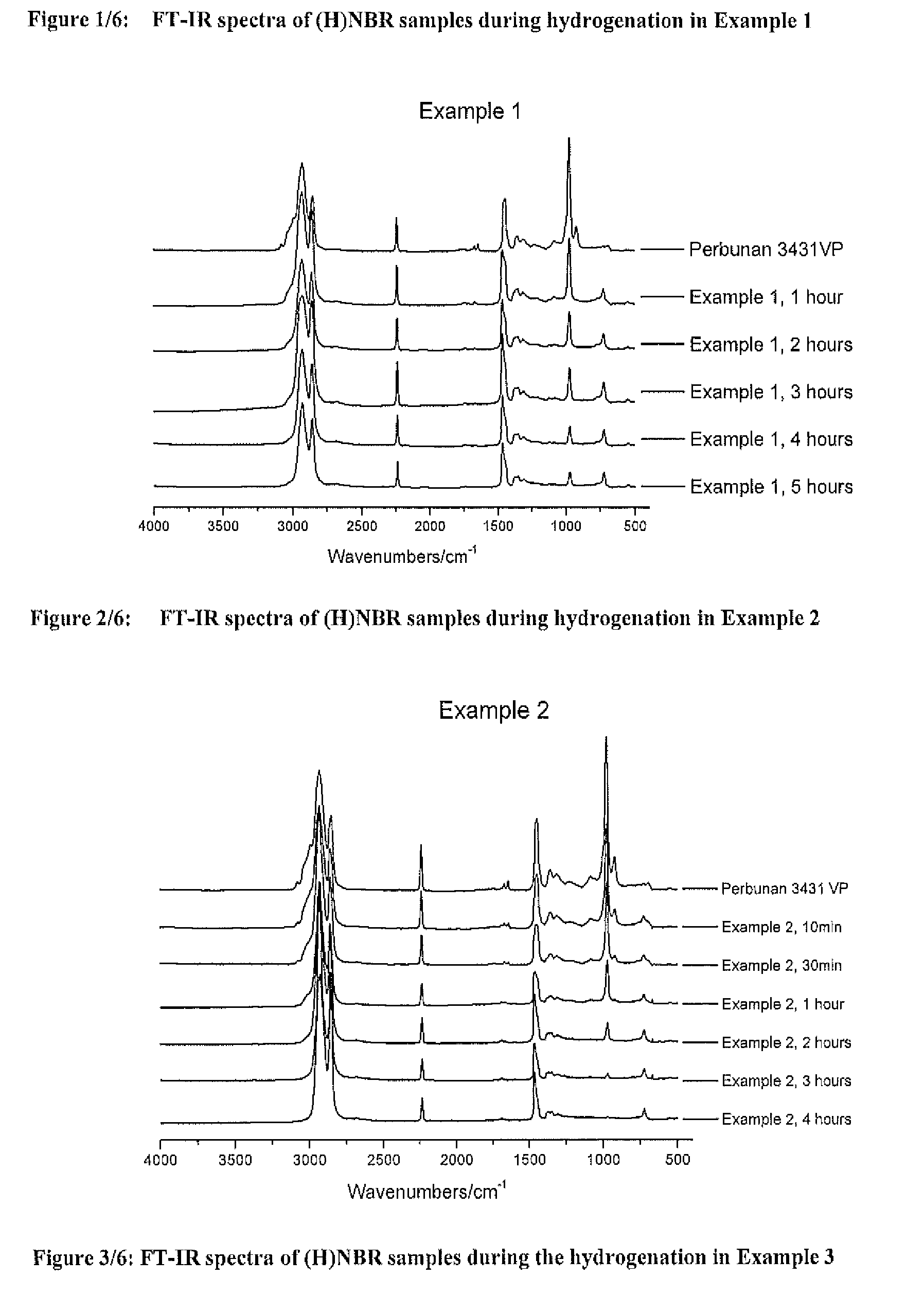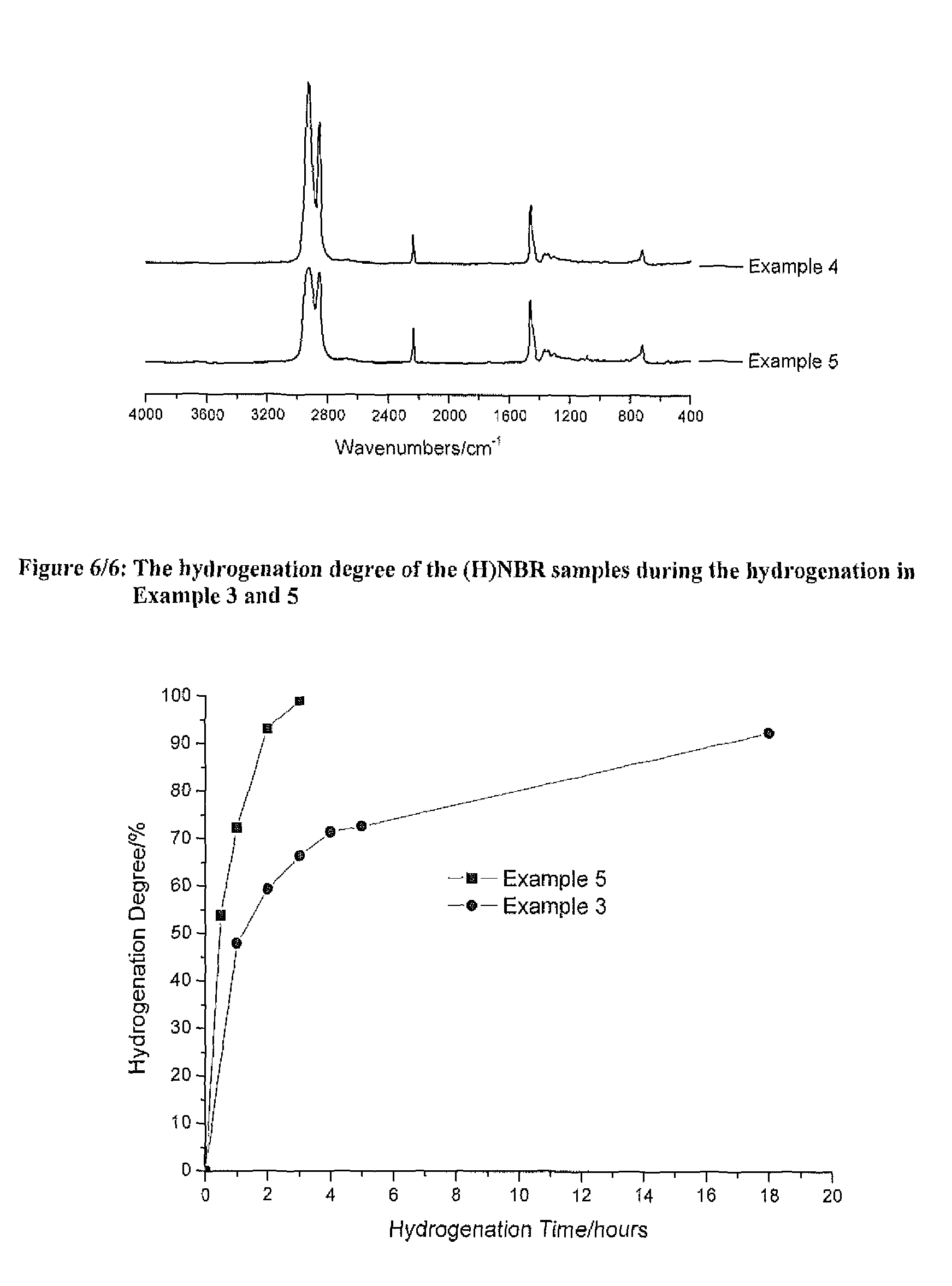Catalyst compositions and their use for hydrogenation of nitrile rubber
- Summary
- Abstract
- Description
- Claims
- Application Information
AI Technical Summary
Benefits of technology
Problems solved by technology
Method used
Image
Examples
example 1
Comparison Example, Using Catalyst (3)
[0438]A solution of 18 g Perbunan® 3431VP in 282 g MCB (Perbunan® 3431VP concentration of 6 wt %) was bubbled with nitrogen in a 600 mL Parr autoclave for 30 minutes, and then heated to 120 C. Wilkinson's catalyst (15 mg) and PPh3 (18 mg) was dissolved in another 20 mL of degassed MCB and then shot into the reactor. Hydrogenation was conducted under 600 psi of hydrogen pressure and 800 rpm of agitation speed. Samples were taken from the reactor at intervals for IR analysis to determine the hydrogenation degree. After 5 hours of hydrogenation, the hydrogenation degree reached 90.3%, the reactor was cooled to room temperature and the pressure was released. The final molecular weight and the distribution were: Mn=76,286, Mw=260,572, PDI=3.42.
example 2
Comparison Example, Using Catalyst (2) without Hydrogen Pretreatment
[0439]A solution of 9 g Perbunan® 3431VP in 291 g MCB (Perbunan® 3431VP concentration of 3 wt %) was bubbled with nitrogen in a 600 mL Parr autoclave for 30 minutes, and then heated to 120° C. Zhan 1B (9 mg) was dissolved in another 20 mL of degassed MCB and then shot into the reactor. Hydrogenation was conducted under 600 psi of hydrogen pressure and 800 rpm of agitation speed. Samples were taken from the reactor at intervals for IR analysis to determine the hydrogenation degree. After 4 hours of hydrogenation, the hydrogenation degree reached 98.6%. The final molecular weight and the distribution were: Mn=5,560, Mw=14,407, PDI=2.59. The obtained HNBR has a much lower molecular weight than the original NBR feedstock
example 3
Comparison Example, Using Catalyst (2) without Hydrogen Pretreatment
[0440]A solution of 18 g Perbunan® 3431VP in 282 g MCB (Perbunan® 3431VP concentration of 6 wt %) was bubbled with nitrogen in a 600 mL Parr autoclave for 30 minutes, and then heated to 120° C. Zhan 1B (18 mg) was dissolved in another 20 mL of degassed MCB and then shot into the reactor. Hydrogenation was conducted under 600 psi of hydrogen pressure and 800 rpm of agitation speed. Samples were taken from the reactor at intervals for IR analysis to determine the hydrogenation degree. After 18 hours of hydrogenation, the hydrogenation degree reached 92.6%. The final molecular weight and the distribution were: Mn−10,103, Mw=19,964, PDI=1.98. The obtained HNBR has a much lower molecular weight than the original NBR feedstock.
[0441]The conditions and the results for Example 1-3 are shown in Table 1 and Table 2
TABLE 1Comparison Examples 1-3: The conditions for the NBR hydrogenationwithout catalyst pretreatmentPerbunanhydr...
PUM
| Property | Measurement | Unit |
|---|---|---|
| Temperature | aaaaa | aaaaa |
| Temperature | aaaaa | aaaaa |
| Temperature | aaaaa | aaaaa |
Abstract
Description
Claims
Application Information
 Login to View More
Login to View More - R&D
- Intellectual Property
- Life Sciences
- Materials
- Tech Scout
- Unparalleled Data Quality
- Higher Quality Content
- 60% Fewer Hallucinations
Browse by: Latest US Patents, China's latest patents, Technical Efficacy Thesaurus, Application Domain, Technology Topic, Popular Technical Reports.
© 2025 PatSnap. All rights reserved.Legal|Privacy policy|Modern Slavery Act Transparency Statement|Sitemap|About US| Contact US: help@patsnap.com



